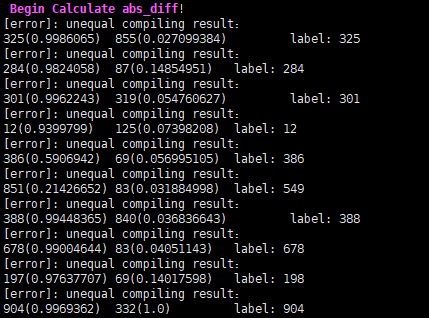After tuning, and use the with autotvm.apply_graph_best() to compile the model, the compiled model can not predict correctly, and why?
when I removed the sentence with autotvm.apply_graph_best(graph_opt_sch_file), the compiled model have a same predict result with origin model.
Note that, for reducing the tuning time, we only run 2 times tuning. and set runner=autotvm.LocalRunner(number=1, repeat=1, min_repeat_ms=2), most of the other code is
similar with the tutorial https://tvm.apache.org/docs/tutorials/autotvm/tune_relay_x86.html#sphx-glr-tutorials-autotvm-tune-relay-x86-py
When I compile other model with TVM, It also have a worng predit results , bug seems not related with the model.
the code is as following
# -*- encoding=utf-8 -*-
import keras
import os
import tvm
import tvm.relay as relay
import numpy as np
from PIL import Image
from tvm.contrib import graph_runtime
from tvm.autotvm.tuner import XGBTuner, GATuner, RandomTuner, GridSearchTuner
from tvm.autotvm.graph_tuner import DPTuner, PBQPTuner
from tvm import autotvm
import sys
import codecs
sys.stdout = codecs.getwriter("utf-8")(sys.stdout.detach())
base_dir = '/share_container/data/'
def image_resize(x, shape):
x_return = []
for x_test in x:
tmp = np.copy(x_test)
img = Image.fromarray(tmp.astype('uint8')).convert('RGB')
img = img.resize(shape, Image.ANTIALIAS)
x_return.append(np.array(img))
return np.array(x_return)
def getTestData(project, dataset_dir):
data_path = os.path.join(dataset_dir, "imagenet-val-1500.npz")
data = np.load(data_path)
x, y = data['x_test'], data['y_test']
input_shape = (224, 224)
input_precessor = keras.applications.resnet50.preprocess_input
x_resize = image_resize(np.copy(x), input_shape)
x_test = input_precessor(x_resize)
y_test = keras.utils.to_categorical(y, num_classes=1000)
return x_test, y_test, input_shape
def tune_kernels(tasks,
measure_option,
tuner='gridsearch',
early_stopping=None,
log_filename='tuning.log'):
for i, task in enumerate(tasks):
prefix = "[Task %2d/%2d] " % (i+1, len(tasks))
# create tuner
if tuner == 'xgb' or tuner == 'xgb-rank':
tuner_obj = XGBTuner(task, loss_type='rank')
elif tuner == 'ga':
tuner_obj = GATuner(task, pop_size=50)
elif tuner == 'random':
tuner_obj = RandomTuner(task)
elif tuner == 'gridsearch':
tuner_obj = GridSearchTuner(task)
else:
raise ValueError("Invalid tuner: " + tuner)
# do tuning
# n_trial=len(task.config_space)
n_trial = 2 # replace n_tral = 2 to reduce running time;
tuner_obj.tune(n_trial=n_trial,
early_stopping=early_stopping,
measure_option=measure_option,
callbacks=[
autotvm.callback.progress_bar(n_trial, prefix=prefix),
autotvm.callback.log_to_file(log_filename)])
def tune_graph(graph, dshape, records, opt_sch_file, target, use_DP=True, input_tensor="input_1"):
target_op = [relay.op.get("nn.conv2d"),]
Tuner = DPTuner if use_DP else PBQPTuner
executor = Tuner(graph, {input_tensor: dshape}, records, target_op, target)
executor.benchmark_layout_transform(min_exec_num=2)
executor.run()
executor.write_opt_sch2record_file(opt_sch_file)
def compare(model_path, is_tuning=True):
# ######################## before compile ##########################################################
project_name = model_path.split('/')[-1].split('-')[0]
x_test, y_test , input_pic_size = getTestData(project_name, base_dir + "dataset")
predict_model = keras.models.load_model(model_path)
predict_model.summary()
res_frame = predict_model.predict(x_test[:100]) # use 10 pictures to test
print(res_frame)
print(res_frame.shape)
acc = 0
for i in range(100):
# print(np.argmax(res_frame[i]), np.argmax(y_test[i]))
if np.argmax(res_frame[i]) == np.argmax(y_test[i]):
acc += 1
print("acc=", acc /100.0)
# return
# ############################ load keras model to relay IRModule ##################################
batch_size = 10 # use 10 pictures to test
input_shape = (batch_size, 3, input_pic_size[0], input_pic_size[1])
output_shape = (batch_size, 1000)
input_tensor = predict_model.input.name.split(':')[0]
shape_dict = {input_tensor: input_shape}
target = 'llvm -mcpu=core-avx2'
ctx = tvm.cpu(0)
irmod, params = relay.frontend.from_keras(predict_model, shape_dict)
# ######################### Run tuning for some operators #############################################
print('\033[1;35m build a task \033[0m')
tuning_option = {
'log_filename': log_file,
'tuner': 'random',
'early_stopping': None,
'measure_option': autotvm.measure_option(
builder=autotvm.LocalBuilder(),
runner=autotvm.LocalRunner(number=1, repeat=1,
min_repeat_ms=2),
),
}
tasks = autotvm.task.extract_from_program(irmod["main"], target=target,
params=params,
ops=(relay.op.get("nn.conv2d"),))
print('\033[1;35m', log_file, ' ', graph_opt_sch_file, '\033[0m')
print('\033[1;35m run tuning tasks \033[0m')
if not os.path.exists('./' + log_file):
tune_kernels(tasks, **tuning_option)
print('\033[1;35m After tune_kernels \033[0m')
if not os.path.exists('./' + graph_opt_sch_file):
tune_graph(irmod["main"], input_shape, log_file, graph_opt_sch_file, target=target, input_tensor=input_tensor)
# ########################## Compile the RelayIR ####################################################
print('\033[1;35m Compile...\033[0m')
with autotvm.apply_graph_best(graph_opt_sch_file):
with tvm.transform.PassContext(opt_level=3):
graph, lib, params = relay.build_module.build(
irmod, target=target, params=params)
module = graph_runtime.create(graph, lib, ctx)
test_x_tvm = x_test[:batch_size].transpose([0, 3, 1, 2])
dtype = 'float32'
data = test_x_tvm.astype(dtype)
module.set_input(input_tensor, data)
module.set_input(**params)
module.run()
res_tvm = module.get_output(0, tvm.nd.empty(output_shape)).asnumpy()
print(res_tvm)
print(res_tvm.shape)
# ########################### calc diff #################################################
print('\033[1;35m Begin Calculate abs_diff\033[0m!')
abs_diff = 0
for i in range(10):
ori_class = np.argmax(res_frame[i])
compile_class = np.argmax(res_tvm[i])
if ori_class != compile_class:
print("[error]: unequal compiling result: \n"
+ str(ori_class) + "(" + str(np.max(res_frame[i])) + ")\t"
+ str(compile_class) + "(" + str(np.max(res_tvm[i])) + ")\t "
+ "label:", np.argmax(y_test[i]))
if __name__ == '__main__':
model_path = base_dir + "origin_model/"
model_name = "resnet50-imagenet_origin.h5"
model_path += model_name
print(model_path)
log_file = "%s.log" % model_name
graph_opt_sch_file = "%s_graph_opt.log" % model_name
compare(model_path)
the results are as follows:
format: origin_model_predict_result(confidence) compiled_model_predict_result(confidence) label

Hope someone can help me, Thanks in advance.
